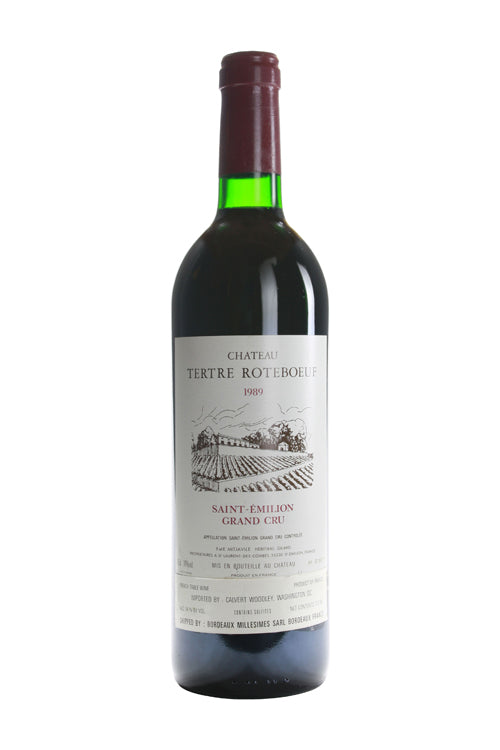1
/
of
1
Tertre Roteboeuf - 1985 (750ml)
Tertre Roteboeuf - 1985 (750ml)
Regular price
$599.99
Sale price
$599.99
Regular price
$699.99
Unit price
/
per
Availability:
1 In Stock
$25 Shipping on Orders +$299
Couldn't load pickup availability
Share :

- varietal
- Region
- Sub - Region
- Type
- Reviews
Product Review
An absolutely spectacular Tertre Roteboeuf, probably the only other vintage that will reach this level of quality is the 2000. The 1990 has a deep plum/ruby color with some lightening at the edge and an extraordinarily flamboyant nose of jammy black cherry and berry fruit infused with smoke, caramel, and coffee notes that soar from the glass. This is a very viscous, full-bodied, silky textured wine has a to-die-for finish and enough glycerin and body to get lost. It is just entering its plateau of full maturity. A wow-wow wine! Anticipated maturity: Now-2015. Last tasted, 12/02.
Product Score
98
Merlot has a reputation for producing smooth, velvety wines that vary depending upon the climate and soil type. Warm conditions on clay soils often produce soft, fruit forward styles. Cool, higher elevation sites produce wine with a slightly more austere structure. It still reigns as one of the world's most noble varieties forming the majority of the blend in Bordeaux’s right bank vineyards of Pomerol and Saint-Emilion. It is now prevalent across the world, achieving particular success in South America, California, and Washington. In central Italy, Merlot is either bottled as a varietal or blended with Sangiovese and Cabernet Sauvignon to form Indicazione Geografica Tipica's (IGT), known as Super Tuscans.
Located in South West France, Bordeaux is one of the World’s most important wine producing regions. The Gironde estuary and its two tributaries, the Garonne and Dordogne, splits the region into the ‘left bank’ and ‘right bank’. The left bank, on the west side of the Gironde, consists of the Médoc and Graves, while Pomerol and St. Emilion are located on the right bank. In between the Garonne and Dordogne is the Entre-Deaux-Mers region, French for 'between two seas'. From north to south the Médoc includes the famous classed growth chateaux in the communes of St. Estephe, Paulliac, St.Julien, and Margaux. The Graves and it’s enclave Pessac-Léognan make both red and white wine. While those of Pessac- Léognan’s are dry, Sauternes and Barsac make world-famous sweet whites. Although Bordeaux makes some of the world’s most expsenive wines, less expensive but good value alternatives come from Moulis and Listrac on the left and Bourg and Blaye on the right offer less expensive wines for earlier consumption.
St. Emilion is the largest of Bordeaux’s right bank appellations, however unlike the grand estates of the Medoc, it is composed of hundreds of small producers, also referred to as garagistes. Merlot and Cabernet Franc dominate with the former accounting for about 60% of all plantings. Some Cabernet Sauvignon is grown, however careful site selection is important as the soils are generally too warm. While the Medoc (left bank) was ranked under the official 1855 classification, it wasn’t for another hundred years until the St. Emilion rolled its own. Where the 1855 classification has only been changed three times, St. Emilion’s, by comparison, is far more dynamic, with a new list drawn up everything ten years. However, as the 2006 classification demonstrated, changes, particularly when producers are demoted, are fiercly contest. Finally passed by the legislature in 2009, the classification comprised of 15 Premier Grand Crus classes and 53 Grands crus classes. The Premiers are broken down further into two groups classes A and B, with Châtea Ausone and Châtea Cheval Blanc in the former and the remaining 13, including such revered producers as Château Angélus, Château Pavie, and Château Figeac, in the latter.
Red wine is wine made from dark-coloured grape varieties. The color of red differs based on the grapes variety or varieties used.Interestingly, black grapes yield a juice that is greenish-white. The actual red color comes from anthocyan pigments (also called anthocyanins) from the skin of the grape (exceptions are the relatively uncommon teinturier varieties, which produce a red colored juice). Most of the production centers around the extraction of color and flavor from the grape skin.


